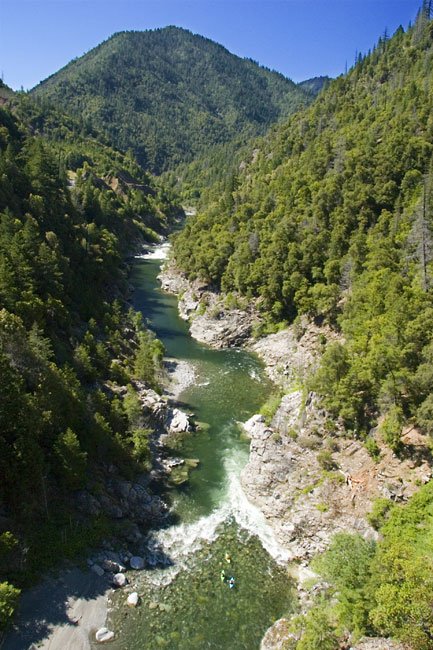Salmon River water temperatures
Water temperatures in the Salmon River and its tributaries have been warming, as air temperatures warm and snowpack decreases.
The Salmon River, flowing from the Salmon Mountains in far Northern California, is one of the most culturally significant watersheds within the Klamath National Forest for the Karuk Tribe. The river hosts spring and fall Chinook salmon, coho, steelhead, green sturgeon, and Pacific lamprey. It has no dams and relatively small amounts of water diverted for human uses, thus making it an excellent location for tracking the effect of climate change on water temperatures. For more information, download the Salmon River Water Temperature chapter.
What does the indicator show?
Salmon River Water Temperatures (1992-2020)
The graph shows the highest temperature (in degrees Fahrenheit) measured during the summer each year at a monitoring station located in the South Fork Salmon River upstream of Black Bear Creek (shown in map below).
- From 1992 to 2020, the highest temperatures recorded each year at the South Fork Salmon River, although variable, have been increasing by about 2 degrees Fahrenheit (°F) per decade.
- At two other sites (Wooley Creek and Salmon River at US Geological Survey gauge stations) water temperatures have been warming more slowly at rates of about 0.5°F per decade (not shown).
The Salmon River flows from the Salmon Mountains (a sub-range of the Klamath Mountains). It joins the Klamath River at about 66 miles upstream from the Pacific Ocean (map), and is its second largest tributary. The Salmon River serves as refuge for at-risk salmon and steelhead stocks in the Pacific Northwest.


Credit: Scott Harding, Riverbend Sciences
Why is this indicator important?
- Water temperature plays a crucial role in river ecosystems as it affects the metabolism, growth rates, reproduction, and distribution of aquatic species.
- In the Salmon River watershed, cold water is especially important for the survival of steelhead, Coho, and Chinook salmon, which are critical for the food security, cultural survival, and well-being of indigenous peoples in the Klamath Basin. Coho salmon in the basin are state and federally listed as threatened, while the spring Chinook salmon is listed as endangered by the State of California as of June 2021.
What factors influence this indicator?
- Summer water temperatures in the Salmon River and its tributaries are warmer due to warming air temperatures, decreased snowpack, earlier snowmelt runoff, and decreased water flow. Years showing higher water temperatures generally coincided with high air temperatures and low stream and river flows.
- Until recently, two Trinity Alps glaciers contributed cold water to the Klamath River basin during the summer. One of two glaciers disappeared entirely in 2015, and the second glacier has since suffered catastrophic loss.
- Other regional factors that affect water temperature include elevation topography and near-stream vegetation. Wildfires in the Salmon River watershed can lead to the loss of trees and vegetation, resulting in reduced shade and warmer river temperatures.
Additional resources
- Salmon River Restoration Council, A quick look at the Salmon River Watershed
